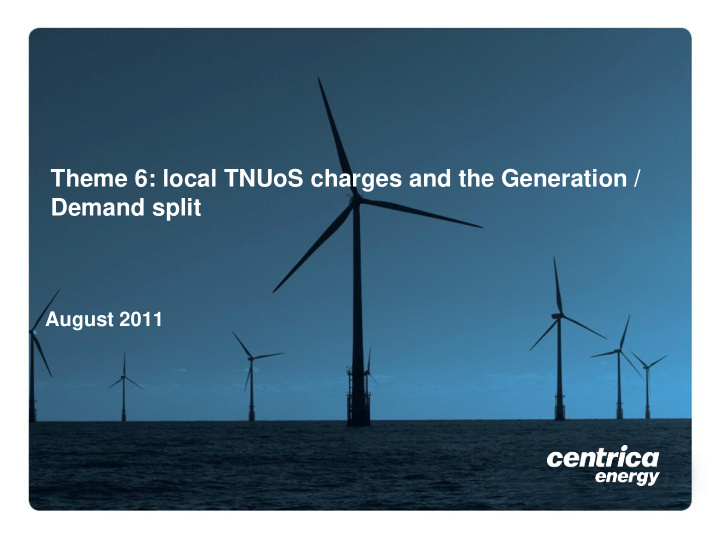



Theme 6: local TNUoS charges and the Generation / Demand split August 2011
TNUoS Charging Post OFTO • National Grid’s target revenue (TNUoS) recovery will increase to include the OFTO revenue streams. • Demand recovers 73% of the new local OFTO costs but in parallel, the majority of the offshore transmission costs are targeted at offshore generators in their Local tariff (circuit and substation tariffs) . • The total amount recovered from all generators cannot exceed the 27%. • Hence, if offshore generators are paying large local charges, the residual element has to be reduced to maintain the overall 27% split. • In practice, demand has paid for 73% of the OFTO costs and offshore generators have also paid for majority of OFTO costs. The correction is delivered by reducing onshore generator charges. 2
Perceived issue of local charges and the falling residual • In Work Group 4 R-UK presented their understanding of the issue • Centrica agrees there is an issue, but views the problem differently • The inclusion of the local costs (especially the OFTO costs) in the 27:73 split: • Significantly decreases the predictability of tariffs • Creates a falling residual which is an unintended consequence and is incongruous from a presentational point of view • Represents a windfall gain to generators Source: National Grid 5 year forecast of Transmission Network Use of System tariffs 3
Solution 1: local charges removed from 27%:73% split • Solution 1 in R- UK’s paper • The only solution that doesn’t reverse the problem by reducing offshore tariffs • G:D split would remain - just for non-local assets • Socialised element of OFTO remains in onshore G:D pot • Prevents G residual tariff from decreasing • D no longer recovers OFTO and local onshore costs • However, generation community pays >27% when offshore generation included 4
Solution 1a - local charges removed from split then alter 27:73 • Same principle as solution 1 but reduces the proportion G pays onshore • The proportion that G pays onshore would need to be reviewed periodically • This solution: • a) Prevents the windfall gains • b) Prevents the onshore residual from falling • c) Improve parties’ ability to forecast tariffs • d) Overcomes, at least in the medium term, the issue of the generator community paying >27% 5
Recommend
More recommend